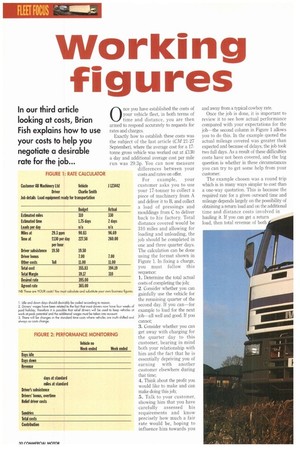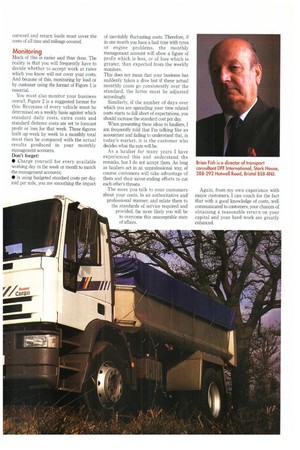Working figures
Page 32

Page 33

If you've noticed an error in this article please click here to report it so we can fix it.
0 nce you have established the costs of your vehicle fleet, in both terms of time and distance, you are then armed to respond accurately to requests for rates and charges.
Exactly how to establish these costs was the subject of the last article (CM 21-27 September), where the average cost for a 17tonne gross vehicle was worked out at £130 a day and additional average cost per mile run was 29.3p. You can now measure differences between your costs and rates on offer.
For example, your customer asks you to use your 17-tonner to collect a piece of machinery from A and deliver it to B, and collect a load of pressings and mouldings from C to deliver back to his factory. Total distance covered would be 310 miles and allowing for loading and unloading, the job should be completed in one and three quarter days. The calculation can be done using the format shown in Figure 1. In fixing a charge, you must follow this sequence:
1. Determine the total actual costs of completing the job; 2. Consider whether you can gainfully use the vehicle for the remaining quarter of the second day. If you can—for example to load for the next job—all well and good. If you cannot; 3. Consider whether you can get away with charging for the quarter day to this customer, bearing in mind both your relationship with him and the fact that he is essentially depriving you of earning with another customer elsewhere during that time; 4. Think about the profit you would like to make and can make doing this job; 5. Talk to your customer, showing him that you have carefully assessed his requirements and know precisely how much a fair rate would be, hoping to influence him towards you and away from a typical cowboy rate.
Once the job is done, it is important to review it to see how actual performance compared with your expectations for the job—the second column in Figure 1 allows you to do this. In the example quoted the actual mileage covered was greater than expected and because of delays, the job took two full days. As a result of these difficulties costs have not been covered, and the big question is whether in these circumstances you can try to get some help from your customer.
The example chosen was a round trip which is in many ways simpler to cost than a one-way quotation. This is because the required rate for a given outward time and mileage depends largely on the possibility of obtaining a return load and on the additional time and distance costs involved in hauling it. If you can get a return
Ailload, then total revenue of both _1
outward and return loads must cover the costs of all time and mileage covered.
Monitoring
Much of this is easier said than done. The reality is that you will frequently have to decide whether to accept work at rates which you know will not cover your costs. And because of this, monitoring by load or by customer using the format of Figure 1 is essential.
You must also monitor your business overall. Figure 2 is a suggested format for this. Revenues of every vehicle must be determined on a weekly basis against which standard daily costs, extra costs and standard distance costs are set to forecast profit or loss for that week. These figures built up week by week to a monthly total must then be compared with the actual results produced in your monthly management accounts.
Don't forget: • Charge yourself for every available working day in the week or month to match the management accounts; • in using budgeted standard costs per day and per mile, you are smoothing the impact of inevitably fluctuating costs. Therefore, if in one month you have a bad time with tyres or engine problems, the monthly management account will show a figure of profit which is less, or of loss which is greater, than expected from the weekly monitors.
This does not mean that your business has suddenly taken a dive but if these actual monthly costs go consistently over the standard, the latter must be adjusted accordingly.
Similarly, if the number of days over which you are spreading your time related costs starts to fall short of expectations, you should increase the standard cost per day.
When presenting these ideas to hauliers, I am frequently told that I'm talking like an accountant and failing to understand that, in today's market, it is the customer who decides what the rate will be.
As a haulier for many years I have experienced this and understand the remarks, but I do not accept them. As long as hauliers act in an unprofessional way, of course customers will take advantage of them and their never-ending efforts to cut each other's throats.
The more you talk to your customers about your costs, in an authoritative and professional manner, and relate them to the standards of service required and provided, the more likely you will be to overcome this unacceptable state of affairs. Again, from my own experience with major customers, I can vouch for the fact that with a good knowledge of costs, well communicated to customers, your chances of obtaining a reasonable return on your capital and your hard work are greatly enhanced.












































































































